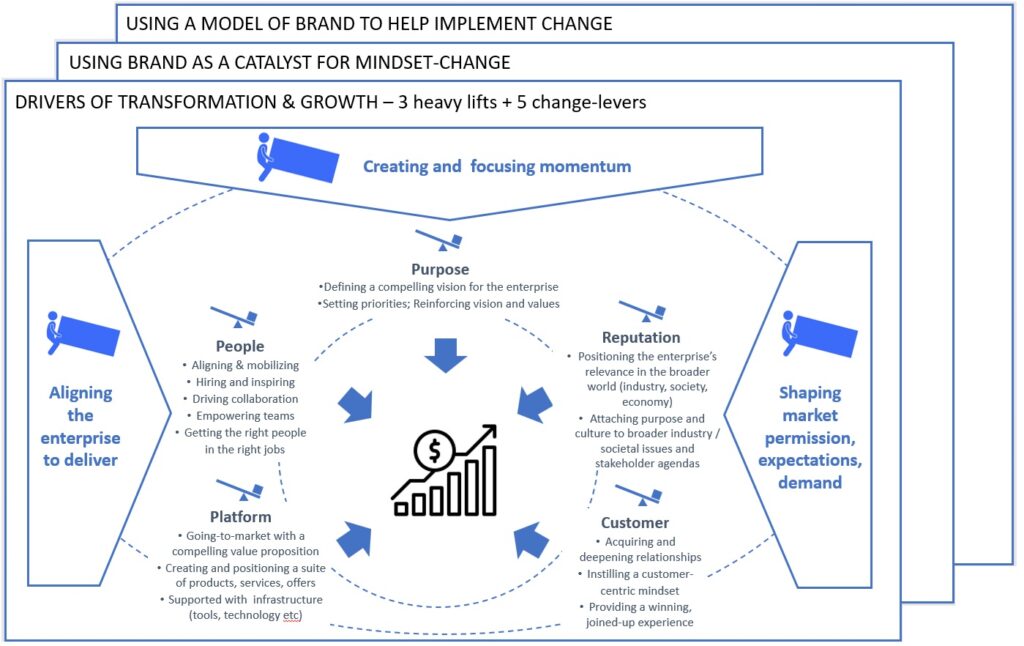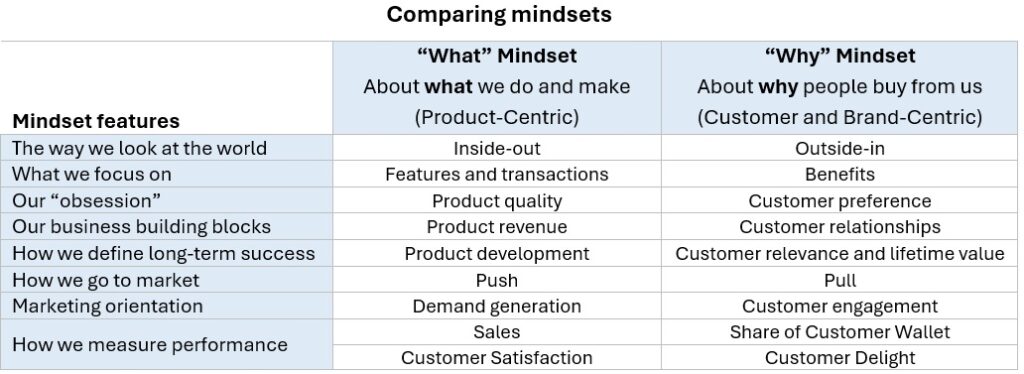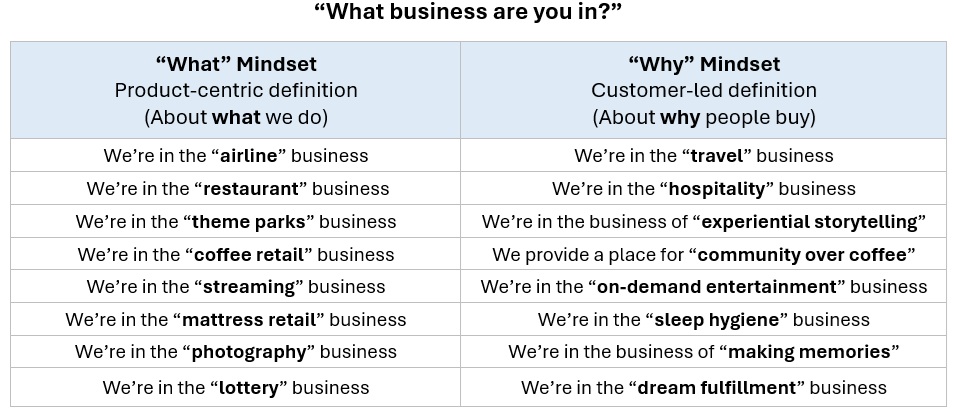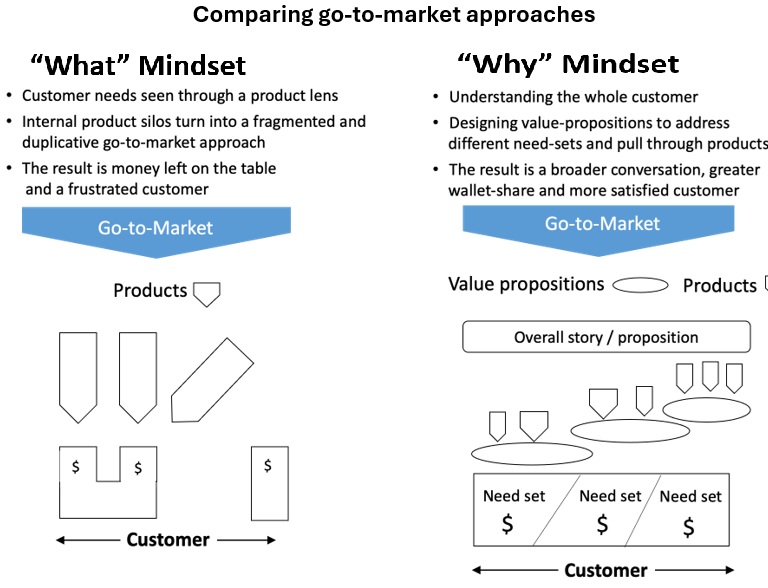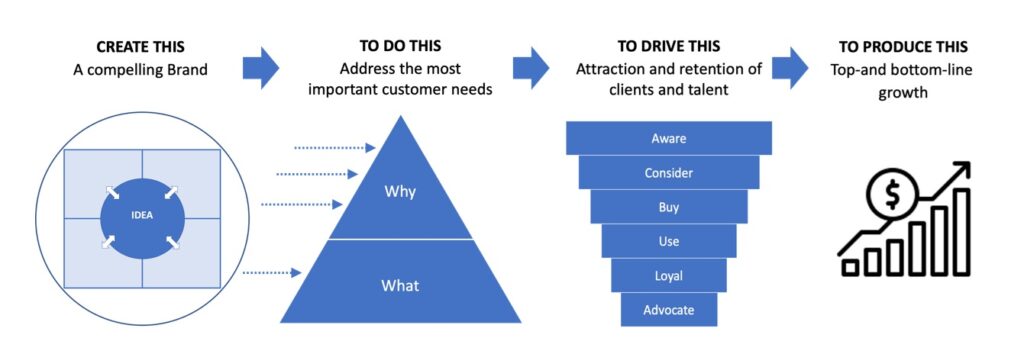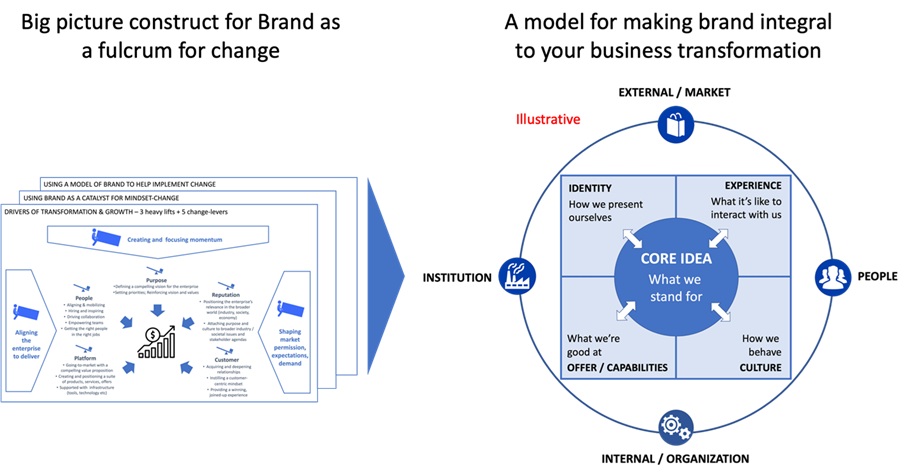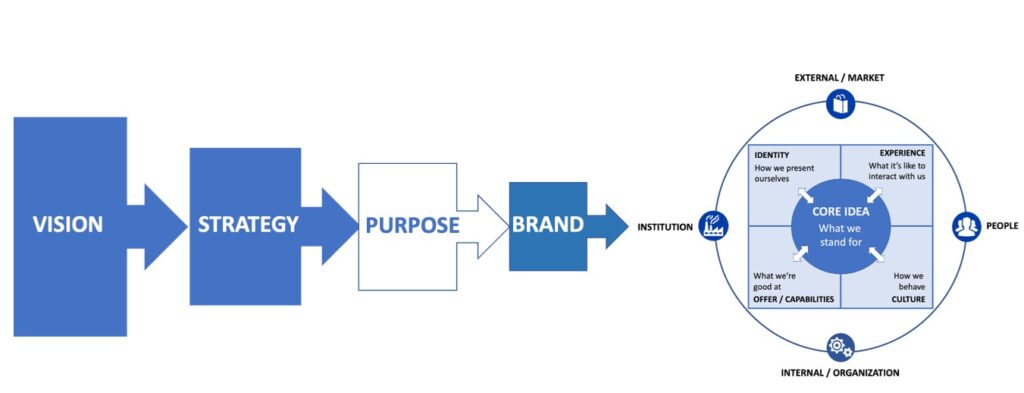by Ian Duncan
Brand means business. If you’re in the B2C world then you already know this – brands exist to generate revenue and profit through the products and services they support. Simple! If, however, you inhabit the B2B universe, and particularly professional services, you’re probably skeptical that there’s any demonstrable link between brand and $ at all. Instinctively it makes sense for there to be, but where’s the proof?
Whether B2C or B2B, what we’re talking about here can be a bit “tricky” to get your head around. We’re not talking about a product brand (unless you’re a one-product business) but about the corporate brand that sits above all your individual product and service brands. One that makes the whole greater than the sum of the parts and therefore has its own value. The good news is that there is a demonstrable link (see below) and therefore you won’t be wasting your time giving brand the attention it deserves.
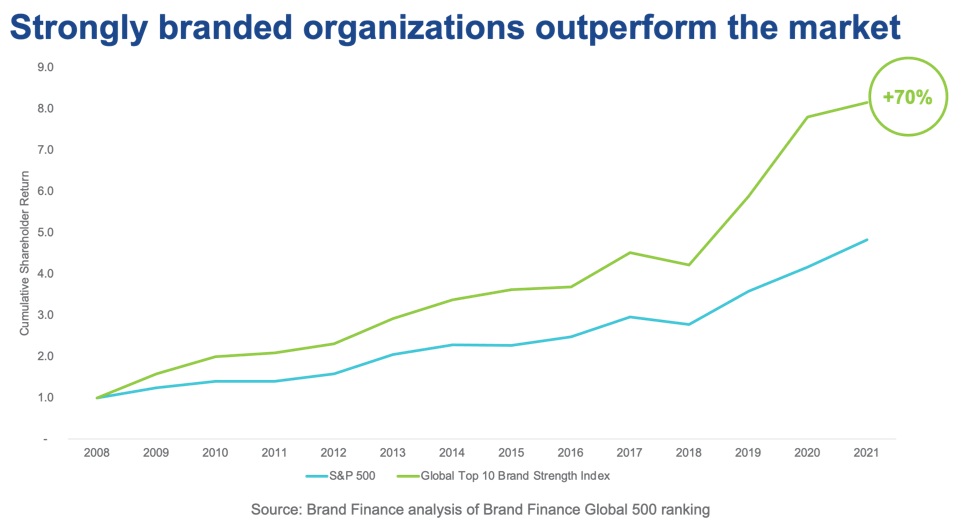
What brand must do for you: Act as a fulcrum to leverage transformation and growth
While it’s comforting to know that, on a meta level, stronger brands translate into superior shareholder returns, we need to get into the specifics of what your corporate brand needs to actually do to help you transform and grow the business you run.
For this we need some sort of construct to make sure brand is doing the right things for the right reasons. I’ve translated what CEO’s themselves have said are their main priorities into a set of transformation and growth “must-dos” – a set of things that brand can also help with. These include 3 “heavy lifts” or “big rocks” that probably land in the CEO’s lap, and 5 “change-levers” that the CEO and their management team need to address.
It takes a fair amount of leverage to shift all this stuff with enough force to make a difference. What you need as CEO is a fulcrum to make it easier. This includes having the right people, finances, systems and organization. Brand is an additional fulcrum you can deploy, and one that can also join up all the others so that your change journey proceeds in a coherent way.
With your transformation and growth agenda in mind, you can use Brand to leverage 2 main things – (i) changing the mindset in the organization, and (ii) activating change in a joined-up and customer-focused way. Both these things fall into the category of a “rising tide which lifts all boats.”
Before we go further I better define what these things are that you need to move – the “big rocks” and the change-levers required to shift them.
Defining the CEO’s 3 “big rocks”
- Momentum: Getting the organization “moving” in the direction of transformation and growth, and in a way that’s sustainable. You may have inherited an organization that’s “stuck”, with in-built inertia or going in the wrong direction. How do you breathe new life into it, and in a positive motivating way?
- Market Permission: Creating “room for growth” by adopting more of an outside-in, customer-centric world view to identify new opportunities. The organization may operate on a “build it and they will come” mindset that’s yielding diminishing returns, and the market may no longer understand what you stand for or how the pieces all fit together. How to get back on the front foot, reclaim your relevance, and make customers want to buy from you again. A reset is required.
- Alignment: Setting up the organization to deliver momentum and growth, making “value-creation” and its translation to top and bottom-line quicker and more efficient. Changing how the organization operates – from siloed to more joined-up. Getting people pulling together, marching behind the same flag and emotionally bought in.
The mindset challenge
Your success in shifting those “big rocks” and change levers is likely predicated on some change to the organization’s prevailing attitudes and behaviors – the lens through which it looks at its world and the culture it creates. This is important and a “biggie” that brand can help you with, so let’s spend a bit of time on the topic.
In order to illustrate the type of change you’re probably confronted with – I’ve described and compared 2 typical mindsets at work in businesses today – the what mindset (where you probably are today and need to move from) and the why mindset (what you likely have to move towards). Changing mindsets and cultures is not easy and they’re often reinforced daily by the organization structure that embodies them. The “why” mindset is brand territory.
“What” mindset or “why” mindset? Trick question
It’s easy to see the “what” mindset as all bad and the “why” mindset as all good, but absolutes are not the reality. As CEO, you’re not going to be able to simply wave a magic wand to switch off “what” mindset and switch on the “why” mindset. I think a more reasonable view is that both these mindsets are essential for business success, but that you need the right blend of them.
A company may reasonably start out with a product focus because it emerged from a product idea, and an obsession with product quality is rarely in itself a “bad” thing. As companies develop and mature though being too product-centric can hamper growth.
So, your task as CEO becomes one of “dialing up” “why” mindset with enough force to make a difference while you have the CEO job, and using Brand as a catalyst to make it happen.
Mindset and growth
In my experience, how an organization looks at the outside world determines how and where it looks for growth opportunities. If it looks at the world through a narrow product lens and all of its customers already have many of its products, it scratches its head about where growth is going to come from- usually “we need more products” – and can become “paralyzed” as a result.
The problem is often rooted in how the organization defines its own business – in many cases far more narrowly than the customer need it could be satisfying and the “wallet” it could be accessing, and with a narrow definition of its competitors. Here’s an illustration of how the what and why mindsets might define the business they’re in.
When the “what” mindset is too dominant it can develop into a “disease” of advanced “myopia” (remember Blackberry anyone….?). If untreated the rot can set in and lead to an organization’s ultimate demise. New product innovations may mask the problem and buy you some time, but not if they’re going to take ages to bring to market or have been developed without significant customer input.
The “why” mindset is the one I think we would all instinctively aspire to if we ran our own business – treating customers as we would want to be treated ourselves. It’s the more “human” way. These companies put the customer at the center of things – it’s ingrained in their culture. They see what they offer as a means to an end rather than an end in itself. For them the building blocks of their business are customer relationships, rather than products. This isn’t some sort of nice-to-have “philosophy” – it translates into greater profit per customer, delivering superior returns.
Where the rubber hits the road
Mindset has a habit of shaping how organizations organize themselves internally and go-to-market (see below). How the organization goes to market often mirrors a product driven internal organization (a case of the tail wagging the dog). Customers don’t care how companies are organized, they care about how their offerings are served up to them.
In the “what” mindset, internal silos translate into a fragmented way of going to market. The customer is the recipient of a disjointed and duplicative experience that starts to raise questions in their own mind about whether the organization has its act together. No-one in the organization seems responsible for, or bothered about, joining the dots at the customer end, so they leave money on the table. They just can’t get out of their own way and become their own competitor.
In the “why” mindset, the organization captures a bigger piece of the pie with a much more joined up approach. They look at the customer more holistically and design broader offers that pull through more products. All this is supported by a bigger story that helps the outside world to understand the value on offer.
In a world where organic growth is hard and getting harder, going to market with the “why” mindset is surely a “no-brainer.” The challenge for CEOs (yes another one) is how to work back from this go-to-market approach on the outside to how the organization is organized on the inside.
Oops! I forgot to define brand!
My AI assistant has annoyingly pointed out that I’ve managed to get this far without defining what a “brand” is. I’ll talk a little about that but what matters most is how we’re going to use Brand to help you transform and grow your business and make $.
Brands are all about the why and translating that into $ – by standing for an “idea” that customers find attractive, gravitate towards, and pay more for (see below). That last bit is important, hence the link between brand and shareholder return. Within organizations, brand often represents the “voice of the customer” and acts as a “beacon” which keeps the organization and its culture steering towards delivering the idea in everything it does.
That “idea” represents a set of perceived attributes or associations that customers hold in their minds, and which resonate with their needs. Stronger and more enduring brands appeal to a customer’s more important “higher order” needs – often those at a deeper, more emotional level. Think “community” vs “coffee.” All this applies to B2B as much as B2C. The last time I looked buying decisions in both B2C and B2B are made by humans (for now).
What we’re concerned with here is applying these principles to a brand that represents, and can move, your whole organization – your “corporate brand”. In future articles I’ll demonstrate how all this brand thinking can be applied to a product as mundane as ball bearings (sorry if you’re in the ball bearing business).
Adopting a Brand Model as an Organizing Idea
“I don’t run a business I run a brand.”–(Howard Schulz, former CEO Starbucks)
Corporate brands have become much more important in recent years as reputation and trust are on the radar screen unlike ever before. Before buying into the organization as a whole or in part, people want to know what it stands for and expect it to “walk the talk.”
“What changed from, say, ten years ago is that the consumer now wants to know the values of the companies behind the brands they buy. That’s becoming increasingly important, especially for younger consumers.”–David Taylor – chair and former CEO of P&G.
The intersection of corporate brand and reputation is a fairly obvious one. But brand is so much more than reputation.
That’s what Howard Schulz was getting at – brand being integral to the way his business works, rather than a layer of branding applied on top of it.
There’s a more transformative and impactful model of brand you can use to move your organization – and in a coherent fashion – in the direction of the “why” mindset (see below).
Thinking like Howard
Future articles will illustrate how to deploy this model of brand to each of the 5 “change-levers.” This is how it supports the CEO’s 3 heavy-lifts of momentum, market permission and alignment.
How the Brand Model provides leverage to move your 3 “big rocks”
- Momentum: By translating your growth ambition and your business imperatives into one single unifying and aspirational idea that both your internal and external stakeholders can buy into….and follow. Bringing that idea to life, “changing the conversation” and mindset internally.
- Market permission: By putting the customer at the center of your brand, as the key ingredient of your “idea.” Anchoring the execution of your identity, experience, offer and culture in the customer. Telling a big story that shapes your reputation, gets you into the consideration set and helps to expand your addressable market.
- Alignment: By joining up execution and delivery of your “idea” across pillars of your transformation effort – the customer experience and how you tell the organization’s “story,” the corporate culture and how you position and deliver your offer. Aligning the outside in with the inside out, and your people agenda with that of the company. Cementing your culture with a sense of belonging and pride.
Where brand fits into your broader change agenda
Given the shortening CEO tenure, we better get the proverbial “ducks in a row” from the start so that your transformation journey can proceed with pace and purpose. If you agree with my way of thinking about brand then make sure it’s part of your “change strategy-making” (see below), not an afterthought. I had the good fortune to work this way at PwC where the Chief Strategy Officer made sure that brand was integral to the process of rethinking the business for its next phase of growth.
So, think of the brand as a key part of your business strategy and a vehicle for bringing it to life.
By now I’ve hopefully persuaded you that brand is an asset you can use to further your transformation and growth agenda. There’s another good reason to give it your consideration – you own it. Yes, the corporate brand is something you as CEO can make yours. As it touches everything and everyone it can act as a “channel” to project your vision inside and outside the organization. And, as data shows (see below), that can be a win-win for both parties.
This is too good an opportunity for you to miss. While change initiatives can easily get bogged down in organizational complexity and politics, your corporate brand can sit above all that as a tool you can wield to hold all those other initiatives accountable to your idea, and therefore to you. Think of brand as your “soft power” at work. Cunning eh?
This series of articles is about how you (a CEO) can develop and use your organization’s corporate brand to help you succeed in delivering transformation and growth. Brand can do a lot for you but its full power as a transformation and growth engine generally goes untapped. So why not get ahead of the pack and give yourself an advantage over your peers. To do so you’ll have to challenge some of your assumptions about what a brand is and how it can work, but it’s worth the effort.
The first article in this series covered why CEOs need help today.
